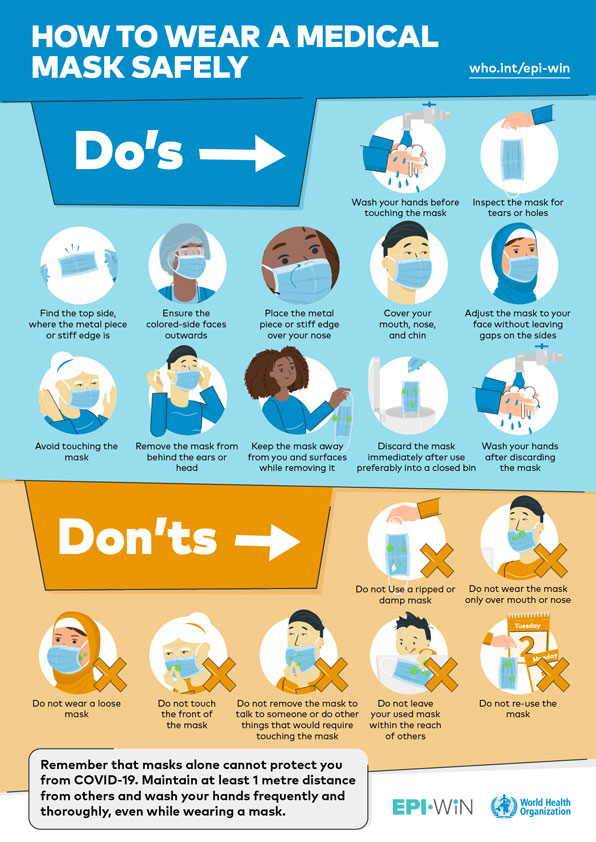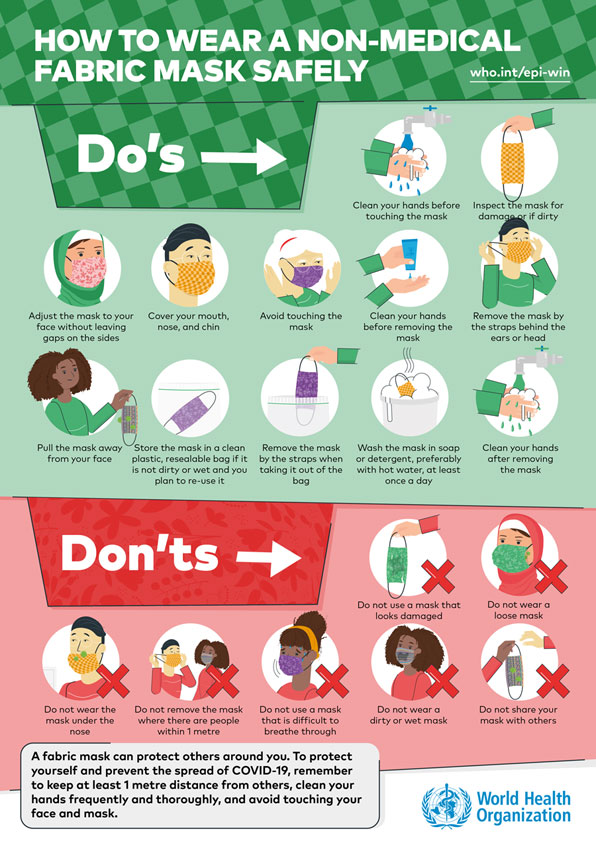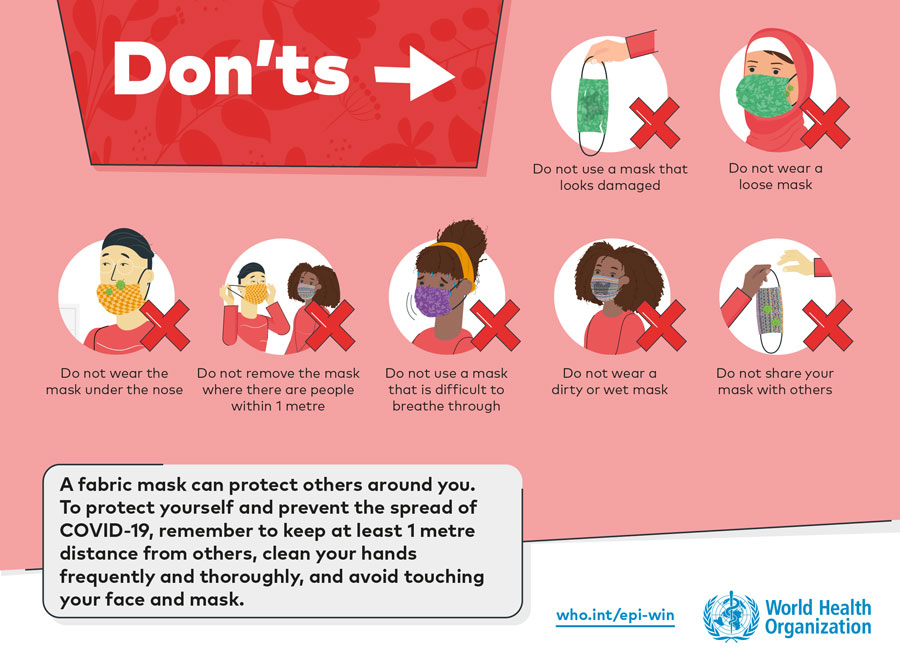The World Health Organisation (WHO) recommends that masks should be worn in areas where the virus is circulating, masks should be worn when you’re in crowded settings, where you can’t be at least 1 metre from others, and in rooms with poor or unknown ventilation.
Appropriate use is essential to make wearing masks effective. Even when masks are worn properly, people should still keep physical distance from others as much as possible. Wearing a mask does not mean you can have close contact with people. Medical masks are for single use only.
Masks should not be worn during vigorous physical activity because of the risk of reducing your breathing capacity. No matter how intensely you exercise, keep at least 1 metre away from others, and if you’re indoors, make sure there is adequate ventilation.
The appropriate use, storage and cleaning or disposal of masks are essential to make them as effective as possible.
Here are the basics of how to wear a mask:
- Clean your hands before you put your mask on, as well as before and after you take it off, and after you touch it at any time.
- You should always clean your hands before and after using a mask, and before touching it while wearing it.
- Make sure it covers both your nose, mouth and chin.
- When you take off a mask, store it in a clean plastic bag, and every day either wash it if it’s a fabric mask, or dispose of a medical mask in a trash bin.
- Do not use masks with vents or exhalation valves, because they allow unfiltered breath to escape the mask.
There are two kinds of masks: Medical masks and Fabric masks. Medical masks are for protecting healthy people. Fabric masks are for preventing onward transmission.
Medical masks are for single use only and should not be reused.
Do not use Fabric masks with vents or exhalation valves, because they do not prevent onward transmission.
Medical masks are recommended for:
- Health workers in clinical settings.
- Anyone who is feeling unwell, including people with mild symptoms, such as muscle aches, slight cough, sore throat or fatigue.
- Anyone awaiting COVID-19 test results or who has tested positive.
- People caring for someone who is a suspected or confirmed case of COVID-19 outside of health facilities.
Medical masks are also recommended for the following groups, because they are at a higher risk of becoming seriously ill with COVID-19 and dying:
- People aged 60 or over.
- People of any age with underlying health conditions, including chronic respiratory disease, cardiovascular disease, cancer, obesity, immunocompromised patients and diabetes mellitus.
Fabric masks (Non-medical masks) can be used by the general public under the age of 60 and who do not have underlying health conditions.
Medical masks
Medical masks (also known as surgical masks) are:
- Composed of 3 layers of synthetic nonwoven materials
- Configured to have filtration layers sandwiched in the middle
- Available in different thicknesses
- Have various levels of fluid-resistance and filtration
How to put on and take off a medical mask:
- Before touching the mask, clean your hands with an alcohol-based hand rub or soap and water.
- Inspect the mask for tears or holes; do not use a mask that has previously been worn or is damaged.
- Verify which side is the top – this is usually where the metal strip is.
- Then, identify the inside of the mask, which is usually the white side.
- Place the mask on your face covering your nose, mouth and chin, making sure that there are no gaps between your face and the mask. Place the straps behind your head or ears. Do not cross the straps because this can cause gaps on the side of the mask.
- Pinch the metal strip so it moulds to the shape of your nose.
- Remember, do not touch the front of the mask while using it to avoid contamination; if you accidentally touch it, clean your hands.
How to take off a medical mask:
- Before touching the mask, clean your hands with an alcohol-based hand rub or soap and water.
- Remove the straps from behind the head or ears, without touching the front of the mask.
- As you remove the mask, lean forward and pull the mask away from your face.
- Medical masks are for single use only; discard the mask immediately, preferably into a closed bin.
- Clean your hands after touching the mask.
- Be aware of the condition of the mask; replace it if it gets soiled or damp.

Fabric masks
Fabric masks can protect others around you.
Fabric masks should be made of three layers of fabric:
- Inner layer of absorbent material, such as cotton.
- Middle layer of non-woven non-absorbent material, such as polypropylene.
- Outer layer of non-absorbent material, such as polyester or polyester blend.
How to put on and wear a fabric mask:
- Before touching the mask, clean your hands with an alcohol-based hand rub or soap and water.
- Inspect the mask for tears or holes, do not use a mask that is damaged.
- Adjust the mask to cover your mouth, nose, and chin, leaving no gaps on the sides.
- Place the straps behind your head or ears. Do not cross the straps because this can cause gaps on the side of your face.
- Avoid touching the mask while wearing it. If you touch it, clean your hands.
- Change your mask if it gets dirty or wet.
How to take off and store a fabric mask:
- Clean your hands before taking off the mask.
- Take off the mask by removing it from the ear loops, without touching the front of the mask.
- If your fabric mask is not dirty or wet and you plan to reuse it, put it in a clean plastic, resealable bag. If you need to use it again, hold the mask at the elastic loops when removing it from the bag. Clean your mask once a day.
- Clean your hands after removing the mask.
How to clean a fabric mask:
- Wash fabric masks in soap or detergent and preferably hot water (at least 60 degrees Centigrade/140 degrees Fahrenheit) at least once a day.
- If it is not possible to wash the mask in hot water, then wash it in soap/detergent and room temperature water, followed by boiling the mask for 1 minute.

Source:




